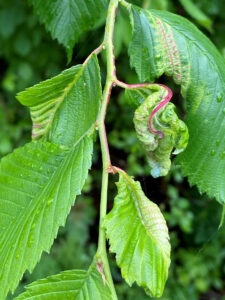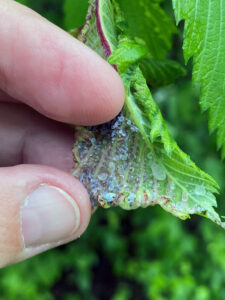
A group of elm leaves shows varying levels of wrinkling and curling, due to feeding by wooly elm aphids on the underside of the leaves. / Photo Credit: Linda Williams, Wisconsin DNR
By Linda Williams, DNR Forest Health Specialist, Woodruff
Linda.Williams@wisconsin.gov or 920-360-0665
Woolly elm aphids (Eriosoma americanum) are a minor pest of American elm. The aphids’ feeding causes leaves to curl at the edges and develop a characteristic wrinkled appearance.
Uncurling the leaves exposes many pale gray aphids on the underside of the leaves, which are protected by the rolled leaf.

Uncurling an elm leaf reveals tiny, bluish-gray oblong shapes — which are the woolly elm aphids — mixed in with round drops of honeydew. / Photo Credit: Linda Williams, Wisconsin DNR
These aphids have a complex life cycle. They spend the first part of the summer feeding on sap from elm leaves, then produce a winged generation that flies to serviceberry and feeds on the roots of that small tree through the remainder of the summer.
In early fall, the aphids develop wings and fly back to American elms, where they will produce a special generation that mates and lays eggs. That is the life stage that overwinters.
Parasitoids, and predators such as ladybugs and lacewings, help control these aphid populations.
In urban plantings, some American elm cultivars are more resistant to this aphid. Researchers from Kentucky evaluated several cultivars and found a range of susceptibility, with the Lewis and Clark Prairie Expedition elm exhibiting no damage from woolly elm aphids.
Chemical control is generally not necessary and is rarely effective, because the aphids are protected within the curled leaf of the elms and protected underground when feeding on serviceberry roots.
